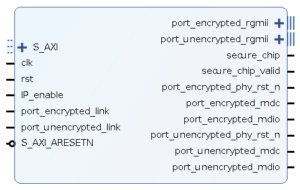- Home
- Technical Products
Enterprise Cloud IT Solutions
Test Measurement
Industrial Measurement
- Solutions
Enterprise Cloud IT Solutions
Test Measurement
- Latest Articles
- About Us
 EN
EN
SASCrypt - IEC 61850/62351
變電站自動化系統密碼IP核
IEC 61850/62351變電站自動化系統加密 ( SAS Crypt ) IP內核可確保變電站自動化系統和新型智能電網場所中使用的嚴格實時流量。例如,它可以保護GOOSE和樣本測量值(SMV)框架,這些框架用於在這些場所(如合並單元或IED)中與關鍵設備進行通信。該IP實施了新的IEC 62351-6標準,該標準可確保互操作性,並允許在同一網絡中同時存在IEC 61850受保護和不受保護的流量。該標準定義了將應用於第2層IEC 61850幀的加密和認證機制。這個低延遲IP核能夠以線速加密,解密和認證GOOSE或SMV。
IEC 62351範圍中的一個非常重要的主題是用於保護的密鑰管理和分發。 SAS Crypt IP Core允許將安全密鑰引入設備的不同方案。由於是將密鑰引入IP的靜態方法,因此一直到IEC 62351-9:“電力系統設備的網絡安全密鑰管理”中定義的用於安全密鑰管理的全自動解決方案。
SAS Crypt IP Core集成了專門針對此任務而優化的專有低延遲加密密碼。該密碼模塊以最佳的資源利用率提供所需的性能,並引入了幾微秒的延遲。實際上,SAS Crypt IP允許在合成時修改支持的數據吞吐量和實施所需的FPGA資源之間的權衡。
允許優化實現的最相關的可配置參數是:
- 必須安全的IEC 61850消息的類型
- 密碼中使用的乘法延遲
- 密碼中使用的乘法引擎
- 用於多達100個不同IEC 61850數據集的密鑰存儲和管理邏輯的實施方案
除保護功能外, SASCrypt IP核還支持IEEE 1588 V2一步透明時鐘對等(P2P)功能。此功能允許補償PTP幀的停留時間以及每個鏈路的延遲。
SASCrypt IP核可與SoC-e MES IP核以及HSR-PRP交換機IP結合使用,以結合安全性在設備中引入以太網交換功能。


SASCrypt IP旨在通過利用新的Xilinx Vivado工具無縫集成到您的FPGA設計中,該工具允許在圖形用戶界面中使用IP內核並以簡便的方式配置IP參數。

SASCrypt IP核的主要功能
- 第2層IEC61850 GOOSE和SMV(采樣測量值)加密、解密和驗證
- 高性能AES-GCM引擎
- 微秒範圍延遲
- 靈活的定制:
⚪必須保護的IEC 61850消息類型
⚪乘法延遲(時間優化)
⚪乘法引擎(資源使用情況)
⚪多達100個不同數據集的密鑰存儲和管理邏輯
connector
- Full-duplex 10/100/1000 Mbps Ethernet interface
- Half-duplex 10/100 Mbps Ethernet interface
- MII/RMII/GMII/RGMII/SGMII/QSGMII Physical Layer Device (PHY) Interface
- 1000 Mbps AXI-Stream接口
- 銅纜和光纖介質接口:10/100/1000Base-T、100Base-FX、1000Base-X
Configuration
- MDIO、UART、AXI4-Lite管理接口
- 購買IP核時附帶驅動程序(*)
Time Synchronization
- IEEE 1588v2 stateless transparent clock function (P2P-Layer 2/E2E-Layer 2)
- 默認、電源實用程序配置文件IEC 61850-9-3
- 與SoC-e IEEE 1588 IP內核兼容(1588Tiny,PTB–PreciseTimeBasic)
Reference Design Supported Boards
- SoC-e SMARTzynq Brick(推薦)
- SoC-e SMARTmpsoc Brick(推薦)
Xilinx FPGA family support
以下Xilinx FPGA系列支持SASCrypt IP:
- 6系列(Spartan,Virtex)
- Series 7 (Zynq, Spartan, Artix, Kintex, Virtex)
- Ultrascale (Kintex, Virtex)
- Ultrascale + (Zynq MPSoC, Kintex, Virtex)
Keeping up with the times and innovating - Explore more potentials of TSN with Hongke
Time Sensitive Networking (TSN) is a new generation of network technology based on the evolution of the standard Ethernet architecture. It takes traditional Ethernet as the network foundation and provides a data link layer protocol specification for deterministic data transmission capability through mechanisms such as clock synchronization, data scheduling, and network configuration. Compared with traditional Ethernet, TSN can provide microsecond-level deterministic services, reduce the complexity of the entire communication network, and realize the convergence of information technology (IT) and operation technology (OT). With its precise clock synchronization, deterministic traffic scheduling, and intelligent and open operation and maintenance management framework, TSN can ensure the high-quality transmission of multiple business traffic in a common network, and it has both performance and cost advantages, and it is the development trend of the future network. This is the future trend of network development.
Currently, TSN technology has a high level of discussion in the automotive, industrial, rail transportation, and aerospace fields. As a non-vendor-bound real-time communication protocol, we believe that TSN technology has a good application prospect.
Welcome to contact us to explore and learn the integration of TSN technology with various industries, and actively promote more applications on the ground to jointly build a new world of intelligent interconnection.

